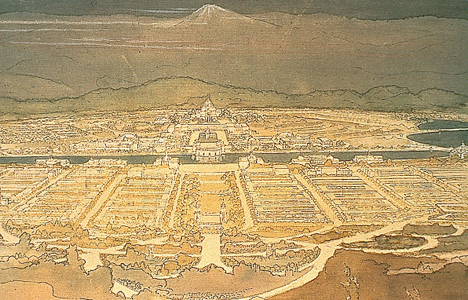 |
| Commonwealth of Australia Federal Capital Competition - Griffin winning entry |
The restored pictures of Marion Mahoney Griffin's artwork for the design of Canberra are on display in the cafe at the National Archives and they make a fabulous backdrop to a chai latte. She and her husband, Walter Burley Griffin, won the design award for Australia's capital and it is thanks to them that Canberra looks largely the way it does.
"I have planned a city not like any other city in the world. I have planned an ideal city - a city that meets my ideal of the city of the future." - Walter Burley Griffin
 |
| View from Summit of Mt Ainslie by Marion Mahony Griffin, 1911 |
The information panels point out that Marion's renderings were infused with sepia and gold and captured the colours of Canberra's landscape. This is all the more remarkable as she had never been to Canberra and instead made the drawings at her home in Chicago in winter 1911. Doubtless she took into account Walter's effusive comments about the light.
"The morning and evening lights at Canberra are wonderful. The shadows of the clouds and the mists as they cross the mountains are very beautiful indeed."
 |
| City and Environs - the Griffin plan for Canberra, 1911 |
Marion Griffin was one of the first licensed female architects in the world and is considered an original member of the Prairie School (of whom Frank Lloyd Wright is the most famous proponent). She and Walter were also greatly influenced by the City Beautiful and Garden City movements. Lacking the cultural history, artefacts and monuments of Old World capitals, the Griffins’ Canberra showcased nature instead. They incorporated the local topography into their triangular design, using the feature hill - Kurrajong Hill (now called Capital Hill) - as a natural apex.
"I think in a new country like Australia, a beautiful architectural type adapted to the needs of the climate, and harmonising with the topography can be evolved. I believe in architecture that is the logical outgrowth of the environment." - Walter Burley Griffin
The Griffins complemented their landscape design with an architectural scheme for the city. Although they worked on the design together, and Marion provided all the artwork, the competition entry featured only Walter's name. Walter negotiated a three-year contract with the Australian government to remain in Australia and oversee the implementation of the plan. He felt, however, that it was compromised and he struggled with political and bureaucratic obstacles. With the outbreak of World War I in 1914, Griffin was under pressure to reduce the scope and scale of the plans due to the Government diverting funds towards the war effort.
 |
| Vision of Parliament House by Marion Mahony Griffin |
The pace of building was slower than expected, partly because of a lack of funds and partly because of a dispute between Griffin and Federal government bureaucrats. The design also came under attack from other architects and the press. Rather than just adhering to the plans and the previously-made commitment, a Royal Commission determined that they had undermined Griffin's authority by supplying him with false data which he had used to carry out his work.
There was clearly a lot of rancour and Walter Burley Griffin resigned from the Canberra design project in December 1920. Many parts of his basic design were changed, and none of the buildings he designed for the capital were ever built.




1 comment:
Interesting Kate - it would have been great to know this before visiting. Cheers
Post a Comment